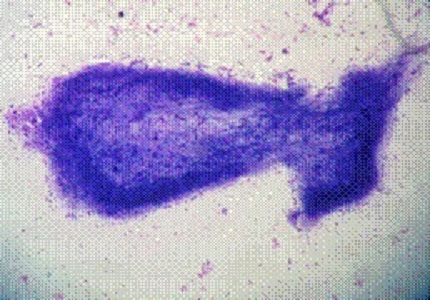Role of FNAC in the diagnosis of cysticercosis
Abstract
Background and Objectives: Cysticercosis is a common tropical disease. Human cysticercosis is caused by the dissemination of the embryo of Taenia solium in the intestine via the hepatoportal system to the tissues and organs of the body. The organs most commonly affected are the subcutaneous tissues, skeletal muscles, lungs, brain, eyes, liver, and occasionally the heart, thyroid, and pancreas. Fine needle aspiration cytology (FNAC) plays an important role in prompt recognition of this disease.
Aims: To study the role of FNAC in the diagnosis of cysticercosis.
Methods: Fifteen patients with subcutaneous and intramuscular nodules, who were clinically diagnosed as lipoma, neurofibroma, lymphadenitis, cold abscess, epidermal inclusion cyst, sebaceous cyst, fibroadenoma and cysticercosis were included in the present study.
Results: In 4 (26.6%) cases, a definitive diagnosis of cysticercosis was obtained in the form of fragments of parasite bladder wall and, biopsy confirmed the diagnosis. In the rest 11 (73.3%) cases, larval fragments could not be identified on the aspirates and the diagnosis of parasitic inflammation was suggested on the basis of other cytomorphological findings. Follow-up biopsy confirmed the diagnosis of cysticercosis.
Conclusions: Cysticercosis is continuing to be a major health problem in developing countries. Fine needle aspiration cytology (FNAC) is cost effective and simple procedure. The cytological diagnosis is quite straightforward in cases where the actual parasite structure is identified in the smears. However, in other cases, presence of eosinophils, histiocytes, a typical granular dirty background are the features which should always alert the pathologist to this possibility.
Downloads
References
2. Craig P, Ito A. Intestinal cestodes. Curr Opin Infect Dis. 2007 Oct;20(5):524-32. [PubMed]
3. García HH, Gonzalez AE, Evans CA, Gilman RH; Cysticercosis Working Group in Peru. Taenia solium cysticercosis. Lancet. 2003 Aug 16;362(9383):547-56. [PubMed]
4. King CH. Cestodes (tapeworms). In: Mandell GL. (ed.) Principles and practice of infectious diseases. 6th ed. Philadelphia: Elsevier Churchill Livingstone; 2005, p. 3289. [PubMed]
5. Garcia HH, Del Brutto OH. Taenia solium cysticercosis. Infect Dis Clin North Am. 2000 Mar;14(1):97-119, ix. [PubMed]
6. Kraft R. Cysticercosis: an emerging parasitic disease. Am Fam Physician. 2007 Jul 1;76(1):91-6. [PubMed]
7. Smiti S, Sripathi H, Naik L. Unusual location of cysticercus lesions in soft tissue-report of three cases. Indian J Radiol Imaging 2003; 13: 157-158.
8. Mamere AE, Muglia VF, Simão GN, Belucci AD, Carlos dos Santos A, Trad CS, Takayanagui OM. Disseminated cysticercosis with pulmonary involvement. J Thorac Imaging. 2004 Apr;19(2):109-11. [PubMed]
9. Pawlowski Z, Allan J, Sarti E. Control of Taenia solium taeniasis/cysticercosis: from research towards implementation. Int J Parasitol. 2005 Oct;35(11-12):1221-32.
10. Allan JC, Velasquez-Tohom M, Garcia-Noval J, Torres-Alvarez R, Yurrita P, et al. Epidemiology of intestinal taeniasis in four, rural, Guatemalan communities. Ann Trop Med Parasitol 1996 Apr:90(2): 157–165.
11. Allan JC, Velasquez-Tohom M, Torres-Alvarez R, Yurrita P, Garcia-Noval J. Field trial of the coproantigen-based diagnosis of Taenia solium taeniasis by enzyme-linked immunosorbent assay. Am J Trop Med Hyg. 1996 Apr;54(4):352-6.
12. García HH, Gilman RH, Gonzalez AE, Verastegui M, Rodriguez S, Gavidia C, Tsang VC, Falcon N, Lescano AG, Moulton LH, Bernal T, Tovar M; Cysticercosis Working Group in Perú. Hyperendemic human and porcine Taenia solium infection in Perú. Am J Trop Med Hyg. 2003 Mar;68(3):268-75. [PubMed]
13. Bourke GJ, Petana WB. Human Taenia cysticercosis: a bizarre mode of transmission. Trans R Soc Trop Med Hyg. 1994 Nov-Dec;88(6):680. [PubMed]
14. Schantz PM, Moore AC, Muñoz JL, Hartman BJ, Schaefer JA, Aron AM, Persaud D, Sarti E, Wilson M, Flisser A. Neurocysticercosis in an Orthodox Jewish community in New York City. N Engl J Med. 1992 Sep 3;327(10):692-5. [PubMed]
15. Willingham AL 3rd, Engels D. Control of Taenia solium cysticercosis/taeniosis. Adv Parasitol. 2006;61:509-66. [PubMed]
16. R. Kraft, “Cysticercosis: an emerging parasitic disease,” American Family Physician, vol. 76, no. 1, pp. 91–98, 2007.
17. F. Bruschi, M. Masetti, M. T. Locci, R. Ciranni, and G. Fornaciari, “Short report: cysticercosis in an Egyptian mummy of the late ptolemaic period,” American Journal of Tropical Medicine and Hygiene.2006 ,74 ,598-99.
18. Kraft R. Cysticercosis: an emerging parasitic disease. Am Fam Physician. 2007 Jul 1;76(1):91-6. [PubMed]
19. Suchitha S, Vani K, Sunila R, Manjunath GV. Fine needle aspiration cytology of cysticercosis-a case report. Case Rep Infect Dis. 2012;2012:854704. doi: 10.1155/2012/854704. Epub 2012 Jul 18. [PubMed]
20. Sawhney M, Agarwal S. Cysticercosis: hooked by a hooklet on fine needle aspiration cytology-a case report. Case Rep Infect Dis. 2013;2013:315834. doi: 10.1155/2013/315834. Epub 2013 Aug 19. [PubMed]
21. Kung IT, Lee D, Yu HC. Soft tissue cysticercosis. Diagnosis by fine-needle aspiration. Am J Clin Pathol. 1989 Dec;92(6):834-5.
22. Vuong PN. Fine needle aspiration cytology of subcutaneous cysticercosis of the breast. Case report and pathogenic discussion. Acta Cytol. 1989 Sep-Oct;33(5):659-62. [PubMed]
23. Kung IT, Lee D, Yu HC. Soft tissue cysticercosis. Diagnosis by fine-needle aspiration. Am J Clin Pathol. 1989 Dec;92(6):834-5. [PubMed]
24. Verma K, Kapila K. Fine needle aspiration diagnosis of cysticercosis in soft tissue swellings. Acta Cytol. 1989 Sep-Oct;33(5):663-6. [PubMed]
25. Nigam S, Singh T, Mishra A, Chaturvedi KU. Oral cysticercosis--report of six cases. Head Neck. 2001 Jun;23(6):497-9. [PubMed]
26. Kamal MM, Grover SV. Cytomorphology of subcutaneous cysticercosis. A report of 10 cases. Acta Cytol. 1995 Jul-Aug;39(4):809-12. [PubMed]
27. V. K. Arora, K. Gupta, N. Singh, and A. Bhatia, “Cytomorphologic panorama of cysticercosis on fine needle aspiration: a review of 298 cases,” ActaCytologica 1994 May-Jun;38(3):377-80. [PubMed]
28. N. Singh, V. K. Arora, and A. Bhatia, “Are all subcutaneous parasitic cysts cysticercosis?” ActaCytol 2006 Jan-Feb;50(1):114-5. [PubMed]
29. Handa U, Garg S, Mohan H. Fine needle aspiration in the diagnosis of subcutaneous cysticercosis. Diagn Cytopathol. 2008 Mar;36(3):183-7. doi: 10.1002/dc.20792. [PubMed]
30. Singh N, Arora VK, Bhatia A. Are all subcutaneous parasitic cysts cysticercosis? Acta Cytol. 2006 Jan-Feb;50(1):114-5.



 OAI - Open Archives Initiative
OAI - Open Archives Initiative


